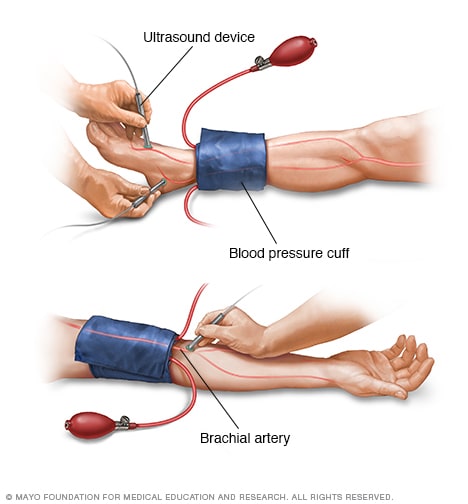Overview
Ankle-brachial index

Ankle-brachial index
To determine the ankle-brachial index, a healthcare professional measures the blood pressure in an ankle and an arm. The ankle-brachial index can help check for peripheral artery disease, also called PAD.
The ankle-brachial index test is a quick, simple way to check for peripheral artery disease (PAD). The disease happens when narrowed arteries reduce the blood flow to the arms or legs. PAD can cause leg pain when walking. PAD also raises the risk of heart attack and stroke.
The ankle-brachial index test compares the blood pressure in the ankle with the blood pressure in the arm. A low ankle-brachial index number can mean there is narrowing or blockage of the arteries in the legs.
Ankle-brachial index testing might be done before and right after walking on a treadmill. This is called an exercise ankle-brachial index test. It can find out how badly the arteries are narrowed when walking.
Products & Services
Why it's done
The ankle-brachial index test is done to check for PAD — narrowed arteries that reduce blood flow, usually in the legs.
An ankle-brachial index test might be useful for people who have leg pain while walking. The test also can be useful for people who have risk factors for PAD.
Risk factors for PAD include:
- History of tobacco use.
- Diabetes.
- High blood pressure.
- High cholesterol.
- Restricted blood flow in other parts of the body due to a buildup of plaque in arteries. This is called atherosclerosis.
Risks
The blood pressure cuffs might cause pain on the arm and leg while they inflate. But this pain is brief and should stop when the air is released from the cuff.
If you have severe leg pain, you may need an imaging test of the arteries in the legs instead.
How you prepare
You don't need to do anything special to prepare for an ankle-brachial index test. It's like having your blood pressure taken in a routine medical visit. Wear loose, comfortable clothing. This lets the healthcare professional doing the ankle-brachial index test easily place a blood pressure cuff on an ankle and upper arm.
What you can expect
During
You likely will be asked to rest for at least 5 to 10 minutes before the test.
Typically, you lie on a table on your back. A healthcare professional measures your blood pressure in both arms and both ankles. This is done using an inflatable cuff and a hand-held ultrasound device that's pressed on the skin. The device uses sound waves to produce images and allows the pulse in the ankle arteries to be heard after the cuff is deflated.
After
The ankle-brachial index test should take only a few minutes. You don't need to take special safety measures afterward. Your healthcare professional talks with you about your test result.
Results
The blood pressure measurements from the arms and ankles are used to determine the ankle-brachial index. The index is a ratio of the two measurements.
Based on the number calculated, your ankle-brachial index may show that you have:
- No artery blockage (1.0 to 1.4). An ankle-brachial index number in this range suggests that you probably don't have PAD. But if you have symptoms of PAD, you might have an exercise ankle-brachial index test.
- Borderline blockage (0.90 to 0.99). An ankle-brachial index number in this range indicates borderline PAD. That means your peripheral arteries may be starting to narrow, but blood flow through them isn't blocked. You might have an exercise ankle-brachial index test.
- PAD (less than 0.90). An ankle-brachial index number in this range indicates a diagnosis of PAD. You might have more testing, such as ultrasound or angiography, to view the arteries in your legs.
People with hard-to-control or long-standing diabetes or significantly blocked arteries might need to have a blood pressure reading at the big toe to get an accurate test result. This reading is called a toe brachial index test.
Depending on how serious the blockage is and your symptoms, treatment might involve:
- Lifestyle changes, including diet changes.
- An exercise or walking regimen.
- Medicines.
- Surgery to treat PAD.
Sept. 18, 2024